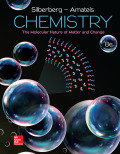
Concept explainers
(a)
Interpretation:
Whether
Concept introduction:
Atoms are neutral in nature. They consist of even smaller particles namely, protons, electrons, and neutrons. Protons have a positive charge on them. Electrons have a negative charge. Neutrons have no charge in them. Protons and neutrons make up the nucleus in the atoms whereas the electrons revolve around the nucleus.
The general representation for an atom is given as
The superscript in the formula of elements or atoms is the mass number. The mass number is the sum of protons and neutrons in the atom. The subscript in the formula represents the atomic number. The atomic number of an element or atom is the number of protons in that element or atom. The difference between the mass number and the number of protons gives the number of neutrons.
The formula to calculate the number of neutrons is,
(a)
Answer to Problem 2.41P
Explanation of Solution
In atoms, the number of protons and electrons is the same since atom is a neutral species. Hence, there are
The formula for calculating the number of neutrons in
Substitute
Substitute
The number of neutrons in
The atomic number of isotopes
The number of protons and electrons in
(b)
Interpretation:
Whether
Concept introduction:
Atoms are neutral in nature. They consist of even smaller particles namely, protons, electrons, and neutrons. Protons have a positive charge on them. Electrons have a negative charge. Neutrons have no charge in them. Protons and neutrons make up the nucleus in the atoms whereas the electrons revolve around the nucleus.
The general representation for an atom is given as
The superscript in the formula of elements or atoms is the mass number. The mass number is the sum of protons and neutrons in the atom. The subscript in the formula represents the atomic number. The atomic number of an element or atom is the number of protons in that element or atom. The difference between the mass number and the number of protons gives the number of neutrons.
The formula to calculate the number of neutrons is,
(b)
Answer to Problem 2.41P
Explanation of Solution
In an atom, the number of protons and electrons is the same since atom is a neutral species. Hence, there are
Substitute
In an atom, the number of protons and electrons is the same since atom is a neutral species. Hence, there are
Substitute
The number of neutrons in
The number of neutrons in
(c)
Interpretation:
Whether
Concept introduction:
Atoms are neutral in nature. They consist of even smaller particles namely, protons, electrons, and neutrons. Protons have a positive charge on them. Electrons have a negative charge. Neutrons have no charge in them. Protons and neutrons make up the nucleus in the atoms whereas the electrons revolve around the nucleus.
The general representation for an atom is given as
The superscript in the formula of elements or atoms is the mass number. The mass number is the sum of protons and neutrons in the atom. The subscript in the formula represents the atomic number. The atomic number of an element or atom is the number of protons in that element or atom. The difference between the mass number and the number of protons gives the number of neutrons.
The formula to calculate the number of neutrons is,
(c)
Answer to Problem 2.41P
The numbers of protons, neutrons, and electrons are different in
Explanation of Solution
In an atom, the number of protons and electrons is the same since atom is a neutral species. Hence, there are
Substitute
In an atom, the number of protons and electrons is the same since atom is a neutral species. Hence, there are
Substitute
The numbers of neutrons in
The mass number
The number of protons, electrons, and neutrons are different in
Want to see more full solutions like this?
Chapter 2 Solutions
EBK CHEMISTRY: THE MOLECULAR NATURE OF
 ChemistryChemistryISBN:9781305957404Author:Steven S. Zumdahl, Susan A. Zumdahl, Donald J. DeCostePublisher:Cengage Learning
ChemistryChemistryISBN:9781305957404Author:Steven S. Zumdahl, Susan A. Zumdahl, Donald J. DeCostePublisher:Cengage Learning ChemistryChemistryISBN:9781259911156Author:Raymond Chang Dr., Jason Overby ProfessorPublisher:McGraw-Hill Education
ChemistryChemistryISBN:9781259911156Author:Raymond Chang Dr., Jason Overby ProfessorPublisher:McGraw-Hill Education Principles of Instrumental AnalysisChemistryISBN:9781305577213Author:Douglas A. Skoog, F. James Holler, Stanley R. CrouchPublisher:Cengage Learning
Principles of Instrumental AnalysisChemistryISBN:9781305577213Author:Douglas A. Skoog, F. James Holler, Stanley R. CrouchPublisher:Cengage Learning Organic ChemistryChemistryISBN:9780078021558Author:Janice Gorzynski Smith Dr.Publisher:McGraw-Hill Education
Organic ChemistryChemistryISBN:9780078021558Author:Janice Gorzynski Smith Dr.Publisher:McGraw-Hill Education Chemistry: Principles and ReactionsChemistryISBN:9781305079373Author:William L. Masterton, Cecile N. HurleyPublisher:Cengage Learning
Chemistry: Principles and ReactionsChemistryISBN:9781305079373Author:William L. Masterton, Cecile N. HurleyPublisher:Cengage Learning Elementary Principles of Chemical Processes, Bind...ChemistryISBN:9781118431221Author:Richard M. Felder, Ronald W. Rousseau, Lisa G. BullardPublisher:WILEY
Elementary Principles of Chemical Processes, Bind...ChemistryISBN:9781118431221Author:Richard M. Felder, Ronald W. Rousseau, Lisa G. BullardPublisher:WILEY





